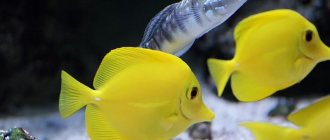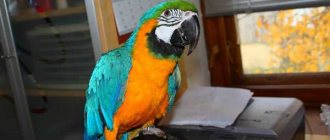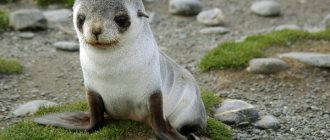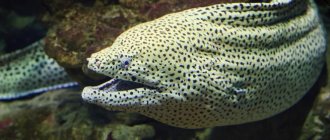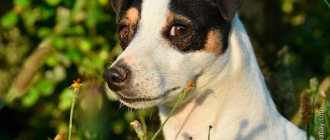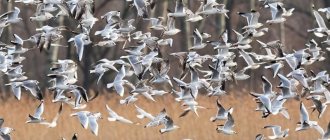Barbs, aquarium fish, are also called barbels. They belong to the popular Carp family, and are represented by a large variety of varieties. With bright and pale colors, large and small, cocky and calm, but always playful inhabitants of the aquarium, in any case, require proper maintenance.
| Full name | Rus. – barb or common barbel. eng. - common barbell, barbs (spines) or barbells (antennae). |
| Kinds | Wild and artificially bred - more than 2000. 43 species are used by aquarists. |
| Color | Diverse, each species has its own bright monochromatic color or there are spots, transverse or longitudinal stripes. |
| Water | t (temperature) from 20 to 26 °C (for spawning it is 2 °C warmer), KH (hardness) from 4 to 10, PH (acid-base balance) - 6.5-8 pH. |
| Stern | Live: bloodworms, tubifex, daphnia, cyclops, brine shrimp. Dry: tablets, flakes, granules from Tetra, Sulfur or Wordley. Frozen and plant foods. |
| Compatibility | With fish without veiled tails and fins: • with swordtails; • clowns; • boots; • platies and other similar ones. |
| Lifespan | 3-5 years, some up to 8-10. |
Sumatran barb
Sumatran barbs are small striped fish up to 6 cm in size. The body color is light golden with 4 vertical black stripes, the fins are red. Selection morphs have been developed: golden (the black color in the color is replaced by white) and mossy (the stripes merge with each other, due to which the body acquires an almost solid black-green color).
Sumatran barbs are hardy and unpretentious, suitable for a beginner’s aquarium. These fish are kept in a school of 6 or more at a temperature of 24-26°C, pH 6.5-7 and dH 5-18°. Barbs are extremely mobile and always remain visible in the aquarium.
Use in cooking
Marlin meat is a very popular ingredient in Japanese cuisine.
Yandex pictures
Chefs use various cooking recipes:
- bake carcasses on the grill;
- stew;
- cook and make fish soups;
- fried in a frying pan in pure form, in batter or in vegetables;
- baked in the oven in sauce or on a bed of vegetables;
- smoked and marinated.
Meat has enormous health benefits. It is low-calorie, so people who adhere to the principles of proper nutrition can safely include it in their diet. The fillet contains the following beneficial substances:
- Polyunsaturated fatty acids Omega-3 and Omega-6. They help improve the function of the cardiac apparatus and vascular system. Strengthen the walls of blood vessels and help get rid of cholesterol plaques. Benefits the skeletal system. Rejuvenate the body at the cellular level, reduce the negative effects of ultraviolet radiation.
- Enzymes. Improves the functioning of the digestive system.
- Easily digestible proteins.
- Phosphorus. Brings great benefits to brain cells.
It is difficult to purchase such a product in Russia. There are no marlin carcasses available for direct sale. You can purchase goods only through specialized points of sale.
Yandex pictures
Danio rerio
Danio rerio is a fish up to 6 cm long. The natural color is light golden with longitudinal dark blue stripes. Breeders have bred pink zebrafish (with bright pink stripes) and leopard zebrafish (the stripes are divided into small spots). In addition, zebrafish became the first genetically modified fish. By changing the genotype, fluorescent GloFish zebrafish were obtained. Their body color can be green, orange, yellow, pink, blue, purple or red with stripes.
Danio rerio are peaceful schooling fish. They are unpretentious and hardy; They feel best at a temperature of 17-25°C, pH 6.7-7 and dH 6-15°.
Catfish platidoras
Platidoras striped is a catfish up to 24 cm long. It has an elongated body of sandy yellow color with wide longitudinal dark brown stripes. There are long whiskers on the head, and there are spikes on the fins. When excited and frightened, the catfish is capable of making fairly loud knocking and clicking sounds.
Platidoras is nocturnal. He spends most of his time during the day buried in the ground, and after turning off the light he goes out in search of food. These striped aquarium fish are kept singly or in groups at a temperature of 24-26°C, pH 5.8-7.5 and dH 2-20°. Platydoras are peaceful, omnivorous and easy to keep.
Leporinus striata
Leporinus striped is an unusual fish with a memorable appearance. Representatives of this species have an elongated body up to 30 cm long, yellow in color with vertical black stripes.
Leporinuses are kept at a temperature of 22-25°C, pH 5.5-7 and dH 10-12°. These fish do not tolerate even minor temperature fluctuations; changes in water parameters cause them stress and often result in death. In this regard, water changes are carried out no more than once a month, replacing no more than 20% of the volume. The aquarium must be equipped with shelters and plants. The leporinus diet should consist of 70% plant food and 30% animal food.
Where does it live?
Marlin fish, or, as it is also called, sailfish, needs comfortable conditions. Water temperature indicators should be at 22-24 degrees Celsius. It lives in open water areas, but for some species it is comfortable in coastal areas.
Yandex pictures
Marlin fish gather in small schools of 10 individuals, no more. They inhabit tropical waters and live in large numbers near the coastal areas of Ceylon and Mauritius. It descends to a level of up to 50 meters or more. Found in the waters of the Atlantic, Pacific and Indian Oceans and adjacent seas.
Siamese algae eater
The Siamese algae eater is a fish up to 16 cm long. Representatives of the species have an elongated silver-colored body; along the sides there is a wide black stripe with jagged edges, extending onto the caudal fin.
Algae eaters are unpretentious and non-aggressive. They are kept at a temperature of 23-29°C, pH 5.5-8 and dH 5-20°. These striped fish are well suited for an aquarium overgrown with algae. Algae eaters eat lower algae, effectively cleaning plant leaves and decorations. At the same time, these fish do not touch higher plants. Algae eaters love to rest on the wide leaves of plants, so suitable species should be planted in the aquarium with them.
Cichlazoma striped
Cichlazoma striped is a cichlid up to 10 cm long. The color is bluish-gray with vertical black stripes. Contain cichlase at a temperature of 22-28°C, pH 7 and dH 5-18°. These fish are characterized by territorial behavior towards both members of their own species and other inhabitants of the aquarium. Therefore, they should be stocked in large volumes (from 100 liters per pair of fish, not counting neighbors of other species). In addition, it is necessary to place a sufficient number of shelters in the aquarium. Cichlazomas love to dig the soil, so the plants are planted in pots.
Description and habitat
Compared to other wild fish, the body length of barbs is considered to be of medium size - 5-30 cm. Barbels are schooling peaceful fish that are constantly moving: they chase each other, burrow, hide and unexpectedly jump out, they like to tease others. Barbs are not demanding when it comes to keeping fish, so it is easy for them to adapt to new conditions. The habitats of wild fish are China, Africa and Southeast Asia. Some species introduced into the waters of Colombia, the USA, Singapore and Australia have successfully taken root there. In these places, large, cheerful flocks of barbs are found in slow-moving rivers and streams, where there is a sandy bottom and a lot of vegetation.
Photo of the barb's native places
Appearance
The body of the barbel is elongated and slightly elongated, the front part is pointed. The tail is formed by two blades. A fish with developed pharyngeal teeth, which are not present on the jaws. Some species have antennae, adding originality to the varied colors. There are types of barbs of one color or with two shades, with spots or marked with stripes running along the body or across. Each species has its own color.
Angelfish
The angelfish is a popular striped aquarium fish. It has a laterally flattened body up to 15 cm long. The dorsal and anal fins are elongated and have the shape of a triangle; The height of the fish with fins reaches 25-30 cm. The natural color is silver with vertical black stripes. Breeders have bred white, black, marbled and blue angelfish, as well as genetically modified GLO angelfish, characterized by a fluorescent pink color without stripes.
Contain angelfish at temperatures above 24°C, pH 6.5-7.5 and dH 5-15°. These are peaceful, calm cichlids that do not dig the soil and do not spoil plants.
Reasons for the name
The fish is called the “blue surgeon” because of the specific fin on its tail. The surface of this part of the body has sharp plates that are hidden under skin folds in a calm state, but are instantly exposed in case of danger.
With the help of the fin, members of the family defend themselves, avoiding contact with people or other inhabitants of the depths. They often attack divers who do not know how dangerous the fish is and try to pet it.
Therefore, if you receive cuts, you should treat the wound with an antiseptic. You should also take antihistamines, as sharp thorns can cause allergies.
Ternetia
Ternetia is a fish up to 5 cm in size. A distinctive feature of this species is its enlarged anal fin. Natural color is silver with 2 vertical black stripes in the front of the body; the back of the body is painted black. White thorns have been bred, as well as genetically modified GloFish thorns with fluorescent colors (green, blue, orange, yellow, red, pink and purple). These morphs have no stripes.
Ternetium is kept in a flock of 6 pieces at a temperature of 22-28°C, pH 6-7.5 and dH up to 20°. The aquarium should have good filtration, aeration and dim lighting, as well as thickets of living plants.
Zebra fish
Zebra fish is a marine fish up to 30 cm in size, distinguished by the bizarre shape of its body and fins. The head is large, the eyes are set high, the pectoral fins are enlarged and fan-shaped. The dorsal and pectoral fins are equipped with spines, to which the excretory ducts of the poisonous glands approach. The poison is dangerous for humans. The color is white with vertical red stripes of different widths; resembles the coloration of a zebra, which is how this striped fish got its name.
Zebra fish are kept at a temperature of 25-26°C and pH 8-8.4. The content of nitrogen compounds should tend to 0. Fish lead a sedentary lifestyle; feed on fish, shrimp and shellfish.
Heckel's discus
Heckel's discus is a fish up to 20 cm in size, characterized by a laterally compressed disc-shaped body. The color is bluish-yellow with multiple narrow longitudinal brown stripes. There are 3 vertical black stripes running through the head, tail and middle of the body. Between them are vertical pale brown stripes.
They contain discus fish at a temperature of 28-32°C, pH 4.2-6.2 and dH 1-5°. These are gentle and whimsical fish. They cannot tolerate sudden fluctuations in water parameters and are susceptible to stress, so any manipulations in the aquarium should be carried out carefully. Good aeration, filtration, dim lighting, plants and shelters are needed.
Diseases and prevention
Proper care and maintenance of barbs allows you to grow healthy aquarium inhabitants that do not create problems. Frequent causes of the disease are weakened fish due to neglect of care rules. Considering barbs to be unpretentious fish, some aquarists do not understand that the fish is sick and requires treatment.
White-skinned
A common disease among barbels, which is introduced by new fish or plants.
How to determine:
- white skin appears next to the tail and dorsal fins;
- the color of the stripes becomes pale;
- the sick barb swims at the top so that the rays of the dorsal fin are visible;
- Appetite decreases, the fish becomes lethargic.
Treated with oxacillin solution, rinsing and disinfecting the aquarium.
Aeromonosis (rubella)
An infectious, common disease that affects barbs. The symptoms of aeromonosis are similar to dropsy. The infection occurs with new fish that have not undergone quarantine.
Obesity
If the fish are fed incorrectly, given more food than normal, they will begin to overeat and become obese. Visible signs of the disease: the body has become larger than normal, the fish has decreased motor activity and has become apathetic. To eliminate the disease, restoration of the correct diet is required. Do not feed the fish for the first 3 days.
Fin rot
Barbs begin to suffer from this disease due to the accumulation of dirt in the aquarium and if the water is cold.
Symptoms:
- the fins are surrounded by a light blue border;
- the length of the fins, which acquire an unnatural color, becomes shorter;
- loss of rays and clouding of the eyes occurs;
- rot destroys the fins, then spreads to the muscles and skin.
They are treated by replacing the water and raising its temperature to 28 degrees. Streptocide is added to the water.
Dropsy
The disease occurs rarely, only in unfavorable conditions. The fish's belly swells, the scales protrude, the anus protrudes, and the barbs become sluggish. Sometimes bulging eyes develop. Sick fish are destroyed, the aquarium with plants is treated with potassium permanganate, then filled with clean water.
Gill rot
A complex infectious disease affects the gills with blood vessels, causing them to rot and collapse. A sick fish's gills turn red, its appetite disappears, it rarely goes down and often hangs upside down. At the first stage, treatment is with rivanol and griseofulvin. In the acute stage, dark blue spots appear in those places on the gills where the tissue has begun to die.
Columnaria
Whitish formations similar to cotton wool, caused by bacteria, appear on affected areas. The development of the disease is slow.
Bloating
Common causes of bloating are: overfeeding, an inflamed gastrointestinal tract if dry food predominates, tumor or the appearance of tapeworms due to low-quality live food.
If the stomach swells slowly, this is obesity; if the problem is rapid, it is an infection.


